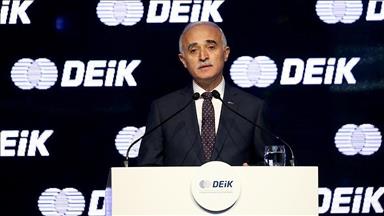 Turkish Treasury and Finance Minister Berat Albayrak speaks as he introduces Turkey’s new Medium Term Program (MTP) at the Dolmabahce Presidential Office in Istanbul, Turkey on September 20, 2018. ( Emrah Yorulmaz - Anadolu Agency )
Turkish Treasury and Finance Minister Berat Albayrak speaks as he introduces Turkey’s new Medium Term Program (MTP) at the Dolmabahce Presidential Office in Istanbul, Turkey on September 20, 2018. ( Emrah Yorulmaz - Anadolu Agency )
Ankara
By Muhammed Ali Gurtas and Tuba Sahin
ANKARA
Turkey's new economic program based on three fundamental pillars -- stabilization, discipline and transformation -- was unveiled on Thursday.
Announcing the program, Treasury and Finance Minister Berat Albayrak said the country will activate a comprehensive set of economic policies.
"A Public Finance Transformation Office has been established under the new economic program," Albayrak said.
"We will use all necessary policies and measures to overcome economic challenges.
"We expect a stabilization process for next year and 2020, so the new economic program aims for 2.3 percent economic growth in 2019," he added.
Albayrak said that this year’s economic growth target is 3.8 percent.
"The country will set sustainable and healthy economic growth through strategies and measures as announced in the new program.
“We aim to reach 3.5 percent growth in 2020 and 5 percent by 2021,” he added.
The Turkish economy grew by 5.2 percent this April-June, preceded 7.3 percent in the first quarter of this year, 7.3 percent in October-December 2017, and 11.5 percent in the third quarter of last year.
Stabilization, discipline
"Our major intention is to support a stabilization process with disciplined public finance," he said.
According to the new economic Medium-Term Program (MTP), Turkey is targeting a 1.9-percent budget-deficit-to-gross-domestic-product (GDP) ratio this year, and 1.7 percent in 2021.
“In order to maintain our strong stance in public finance, we have begun to take some measures to ensure the correct use of resources in the public sector starting today," said Albayrak.
Turkey's central government budget balance posted a deficit of 50.8 billion Turkish liras ($11.4 billion) this January to August. The country's budget revenues totaled 485.7 billion Turkish liras ($109 billion) in the first eight months of this year, up nearly 19 percent year-on-year.
Last year, the budget deficit was 47.4 billion Turkish liras ($12.9 billion), totaling around 1.5 percent of the country's GDP.
Transformation, employment
On transformation, Albayrak said that the main target is to focus on value-added areas which will boost the country's export volume and long-term production capacity.
"You will see the most concrete example of this in investment projects that we will support,” he added.
In creating employment, Albayrak said Turkey will generate 2 million new jobs by the end of the MTP period, with an unemployment rate target of 10.8 percent in 2021.
As of June, Turkey's unemployment rate was 10.2 percent -- some 3.3 million unemployed people -- while the number of people employed was 29.3 million.
Last year, the lowest unemployment rate was seen in May and June with 10.2 percent. Over the past five years, the highest unemployment rate was 13 percent in January 2017, while the lowest was in June 2013 with 8.1 percent.
Struggle with inflation
Albayrak said a specific program of total struggle against inflation would be announced soon.
“Regarding inflation, the Central Bank will continue to use all instruments independently in line with its price stability objective,” he said.
Turkey's annual inflation was 17.90 percent in August, up from July's figure of 15.85 percent.
Over the past five years, the annual inflation saw its lowest level at 6.13 percent in April 2013, while the figure reached its highest level last month.
According to the new MTP, the country's inflation rate target is 20.8 percent this year, 15.9 percent next year, 9.8 percent in 2020, and 6.0 percent in 2021.
Current account deficit
Albayrak also noted that current account gap narrowed significantly this year with the backing of increasing tourism and export revenues.
Turkey's exports from January to August amounted to $108.7 billion with a 5.3-percent rise year-on-year. As of August, the 12-month overall exports reached $162.4 billion.
In 2014, Turkey's exports hit an all-time high of $157.6 billion while the figure was nearly $157 billion last year.
Over the past five years, the highest export-to-import ratio was recorded in 2016 with 71.8 percent, while the country's foreign trade deficit has fallen from $99.8 billion in 2013 to $76.8 billion in 2017.
"Investments in pharmaceuticals, energy, petrochemicals, machinery and equipment, and software sectors will be prioritized in public incentive to reduce current account deficit," Albayrak added.
The MTP is targeting current-account-deficit-to-GDP ratio of 4.7 percent this year, 3.3 percent next year, 2.7 percent in 2020, and 2.6 percent in 2021.
According to the Turkish Central Bank, Turkey's current account deficit in July -- $1.75 billion -- showed an annual down of 62.8 percent, while the 12-month rolling deficit reached $54.6 billion as of July.
Turkey's annual current account deficit in 2017 was around $47.5 billion -- around 5.6 percent of the country's GDP.
As noted in the new MTP, tourism services, including health tourism, will be diversified to increase tourism revenues, while the program aims to generate travel income of $42 billion in 2021.
In the first half of this year, over 17 million foreigners visited Turkey and spent some $11.5 billion. Last year, the country's tourism income was some $26.2 billion while the number of visitors was 38.6 million.
Anadolu Agency website contains only a portion of the news stories offered to subscribers in the AA News Broadcasting System (HAS), and in summarized form. Please contact us for subscription options.


